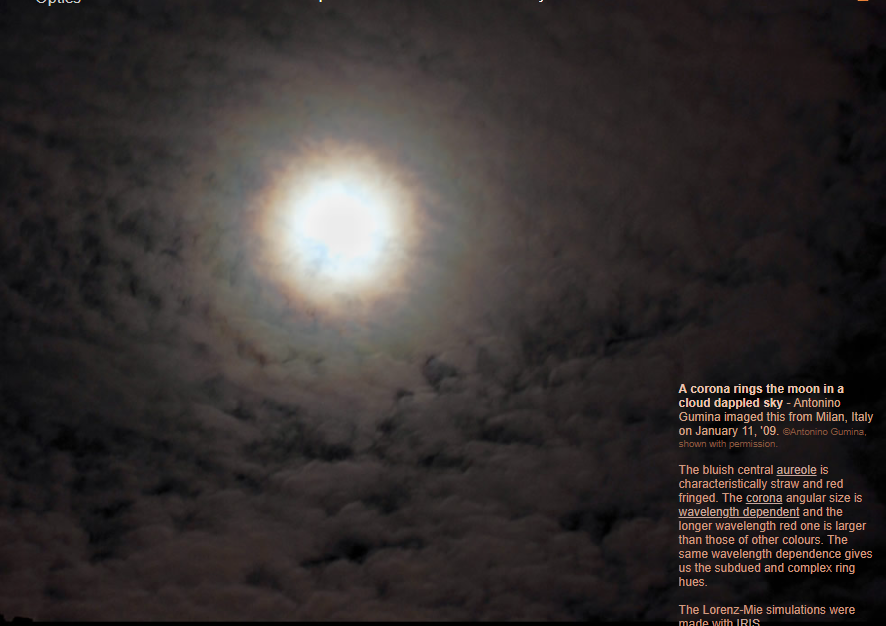Corona Colours
Corona Colours: A Closer Look at the Phenomenon
When gazing at the moon on a cloud-dappled night, you may have noticed a fascinating optical phenomenon known as a corona. This captivating display forms a ring around the moon, with a central aureole that typically exhibits bluish hues and is bordered by straw-colored and red fringes. While the corona's appearance may vary, one interesting characteristic is its color dependence on wavelength. In this article, we will delve deeper into the intriguing world of corona colors and explore the factors that contribute to their formation.
Understanding the Wavelength Dependence
The size of the corona's angular diameter depends on the wavelength of light. Specifically, the longer-wavelength red light produces a larger corona compared to other colors. This variation in size accounts for the subdued and complex hues observed within the corona ring. The interplay between different wavelengths creates a mesmerizing visual spectacle that has captivated sky watchers for centuries.
The Role of Lorenz-Mie Simulations
To gain a better understanding of the corona's intricate color patterns, researchers employ Lorenz-Mie simulations. These simulations utilize the principles established by Gustav Mie and Hendrik Lorentz to model the scattering of light by small particles in the atmosphere. By simulating different scenarios and varying parameters, scientists can explore how different factors contribute to the formation of corona colors.
Factors Influencing Corona Colors
While the wavelength dependence plays a significant role in corona colors, several other factors contribute to the final appearance of this optical phenomenon. Here are some key factors to consider:
-
Particle Size: The size of the atmospheric particles that scatter light affects the overall size and intensity of the corona. Smaller particles tend to create more vibrant and intricate color patterns.
-
Particle Distribution: The distribution of particles in the atmosphere also impacts corona colors. Uniformly distributed particles result in a well-defined corona, while uneven distributions can lead to irregular color patterns.
-
Atmospheric Conditions: The moisture content, temperature, and altitude of the atmosphere influence corona colors. Variations in these factors can cause subtle shifts in the hues and intensities observed.
-
Light Source: The characteristics of the light source, such as its intensity and spectral composition, can influence the appearance of the corona. Different light sources may produce variations in color saturation and overall brightness.
Exploring the Subdued and Complex Ring Hues
The subdued and complex hues observed within the corona ring add to its allure. These hues result from the interference and diffraction of light waves as they interact with atmospheric particles. The intricate interplay between light waves of different wavelengths creates a tapestry of colors that can range from soft pastels to vibrant shades.
Capturing Corona Colors
Photographers and sky enthusiasts often strive to capture the beauty of corona colors through their lenses. Achieving this can be a challenge, as it requires careful consideration of various factors, including:
-
Proper Exposure: Balancing the exposure settings is crucial to capture the subtle nuances of corona colors. Overexposure can wash out the hues, while underexposure may lead to a loss of detail.
-
Optimal Focusing: Achieving precise focus is essential to bring out the intricate details within the corona. Utilizing manual focus and experimenting with different settings can help photographers achieve optimal results.
-
Patience and Persistence: Corona colors can be elusive, requiring patience and persistence to capture them effectively. Waiting for ideal atmospheric conditions and experimenting with different shooting angles can significantly enhance the chances of success.
Unveiling the Mysteries of Corona Colors
Although scientists have made significant strides in understanding corona colors, many mysteries remain. The complex interplay of light waves, atmospheric particles, and other factors continues to intrigue researchers and enthusiasts alike. Through ongoing research and advanced simulations, we inch closer to unraveling the secrets behind this captivating atmospheric optics phenomenon.
In conclusion, the world of corona colors is a fascinating realm that showcases the beauty and complexity of light scattering in our atmosphere. From the wavelength dependence to the factors influencing their formation, understanding the intricacies of corona colors enhances our appreciation of this captivating natural spectacle. So, the next time you find yourself gazing at the moon on a cloud-dappled night, take a moment to marvel at the mesmerizing corona and its myriad of hues.

A corona rings the moon in a cloud dappled sky - Antonino Gumina imaged this from Milan, Italy on January 11, '09. ©Antonino Gumina, shown with permission.
The bluish central aureole is characteristically straw and red fringed. The corona angular size is wavelength dependent and the longer wavelength red one is larger than those of other colours. The same wavelength dependence gives us the subdued and complex ring hues.
The Lorenz-Mie simulations were made with IRIS.

Note: this article has been automatically converted from the old site and may not appear as intended. You can find the original article here.
Reference Atmospheric Optics
If you use any of the definitions, information, or data presented on Atmospheric Optics, please copy the link or reference below to properly credit us as the reference source. Thank you!
-
<a href="https://atoptics.co.uk/blog/corona-colours-2/">Corona Colours</a>
-
"Corona Colours". Atmospheric Optics. Accessed on November 26, 2024. https://atoptics.co.uk/blog/corona-colours-2/.
-
"Corona Colours". Atmospheric Optics, https://atoptics.co.uk/blog/corona-colours-2/. Accessed 26 November, 2024
-
Corona Colours. Atmospheric Optics. Retrieved from https://atoptics.co.uk/blog/corona-colours-2/.